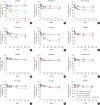Allergenicity and Stability of 6 New Korean Bony Fish Extracts
- PMID: 34212548
- PMCID: PMC8255345
- DOI: 10.4168/aair.2021.13.4.623
Allergenicity and Stability of 6 New Korean Bony Fish Extracts
Abstract
Purpose: Diagnostic tests for allergen sensitization should reflect real exposure. We made 6 new bony fish extracts, which are consumed popularly in Korea, and evaluated their allergenicity and stability.
Methods: We manufactured fish extracts from codfish, mackerel, common eel, flounder, cutlass, and catfish. Protein and parvalbumin (PV) were evaluated by Bradford assay, 2-site enzyme-linked immunosorbent assay, sodium dodecyl sulphate-polyacrylamide gel electrophoresis (SDS-PAGE), and anti-PV immunoblotting. The immunoglobulin E (IgE) reactivities of the extracts were evaluated with ImmunoCAP and IgE immunoblotting using sera from 24 Korean fish allergy patients, 5 asymptomatic sensitizers, and 11 non-atopic subjects. Stability of the extracts stored in 4 different buffers were evaluated for up to a year.
Results: The protein concentrations of commercial SPT fish extracts varied with up to a 7.5-fold difference. SDS-PAGE showed marked differences in the PV concentrations of commercial SPT reagents. Specific IgE measurements for the following investigatory fish extracts-iCodfish, iMackerel, and iEel-were concordant with that of their corresponding Phadia ImmunoCAP measurements. ImmunoCAP results showed marked IgE cross-reactivity among the fish species, and the overall sensitivity of ImmunoCAP with the investigatory fish extracts for identification of culprit fish species was 85.7%. The protein and PV concentrations in the investigatory extracts were highly stable in saline with 0.3% phenol-50% glycerol at 4°C for up to a year.
Conclusions: The commercial SPT fish extracts exhibited considerable variation in terms of allergenicity, which may impact on diagnostic accuracy. Our new fish extracts have sufficient allergenicity and stability and may be adequate to various clinical applications.
Keywords: Allergenicity; bony fish; extracts; fish allergy; fish parvalbumin; food allergy.
Copyright © 2021 The Korean Academy of Asthma, Allergy and Clinical Immunology · The Korean Academy of Pediatric Allergy and Respiratory Disease.
Conflict of interest statement
There are no financial or other issues that might lead to conflict of interest.
Figures







References
-
- Rona RJ, Keil T, Summers C, Gislason D, Zuidmeer L, Sodergren E, et al. The prevalence of food allergy: a meta-analysis. J Allergy Clin Immunol. 2007;120:638–646. - PubMed
-
- Ahn K, Kim J, Hahm MI, Lee SY, Kim WK, Chae Y, et al. Prevalence of immediate-type food allergy in Korean schoolchildren: a population-based study. Allergy Asthma Proc. 2012;33:481–487. - PubMed
-
- Bugajska-Schretter A, Elfman L, Fuchs T, Kapiotis S, Rumpold H, Valenta R, et al. Parvalbumin, a cross-reactive fish allergen, contains IgE-binding epitopes sensitive to periodate treatment and Ca2+ depletion. J Allergy Clin Immunol. 1998;101:67–74. - PubMed

